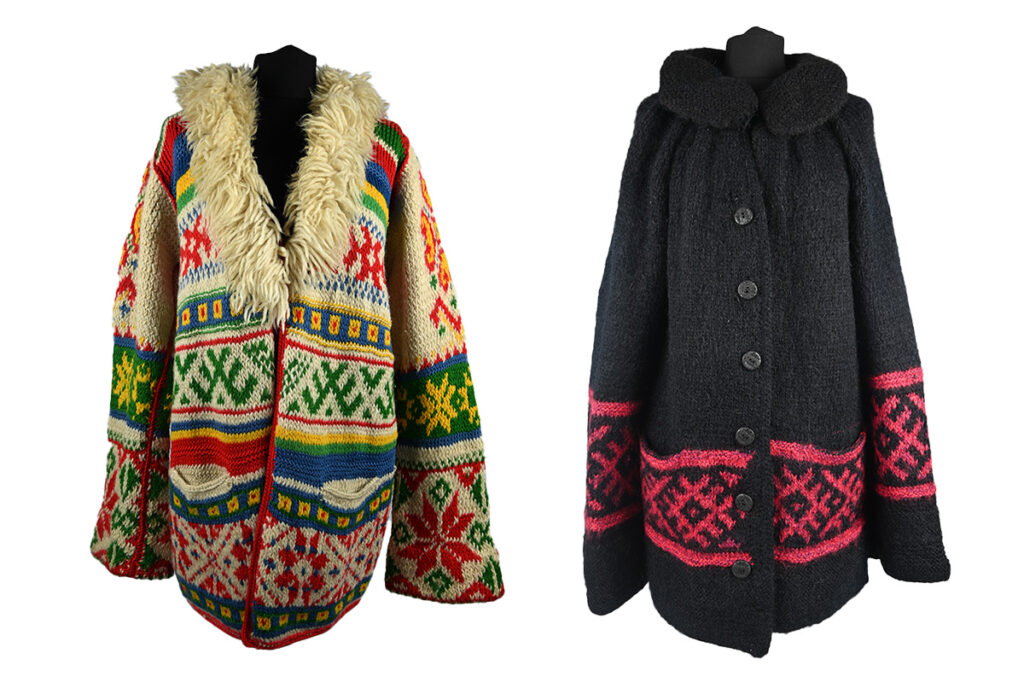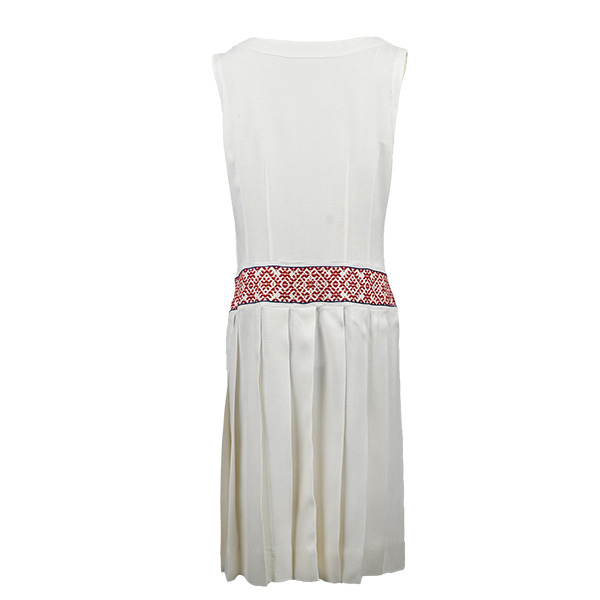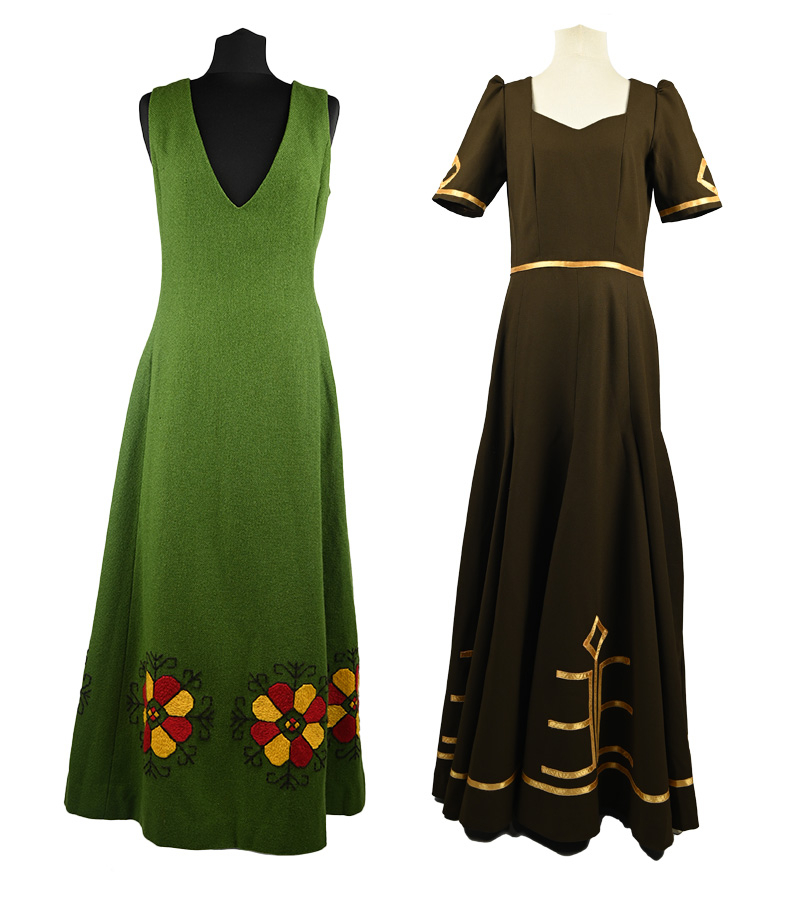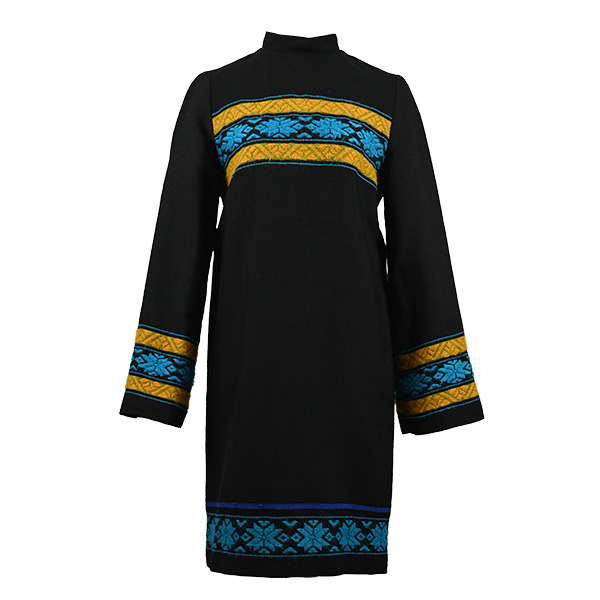Folk costumes. IN exile
Folk design in modern clothing
Although the folk costume is worn at festivals and events to show one’s Latvian identity, Latvians in the diaspora also tend to creatively reveal their ethnicity in everyday life. For example, by making and wearing clothing with a Latvian accent – be it jewellery, traditional Latvian colours, or Latvian designs. Today, Latvians around the world also use various elements of the national folk costumes in their clothing, e.g. woven belts and ribbons, brooches, pastalas (trad. leather footwear), etc.
How to make people notice that you’re Latvian?

Brigita’s Cardigan With Latvian Designs
The cardigan with Latvian designs was knitted for Brigita Stroda by her mother Eleonora Stroda (1915–1991). It was made in Australia in the 1970s. Brigita was studying set design at the Victorian College of the Arts at the time. Brigita recalls: "I was ‘average’ in terms of patriotism, but I was also eccentric. It was difficult for the stylish and young generation born in exile to wear anything Latvian – for example, we all developed an ‘allergy’ to amber. In the 1970s, a particular surfers' alpaca sweater cardigan, knitted in shades of grey with patterned designs and a thick shawl collar, was very fashionable. I thought, if these cardigans are fashionable and if they have patterned designs, why couldn't they be Latvian designs? My mother was a keen knitter, but I usually didn't take her up on her offers. This time, my mum was happy and knitted my design exactly the way I wanted it. This work gave my mother the deepest pleasure and a sense of achievement that her daughter wanted a Latvian piece of clothing, and one knitted by her, no less. I wore this cardigan a lot and everywhere."
Donated by Brigita Stroda. From the collection of the Latvians Abroad Museum and Research Centre (LP2015.125-126).

Linen dress
This linen dress with a woven folk-style belt was made by Baiba Ozola (1928–2017) in Canada in the 1960s. Baiba somehow found a fine linen fabric for the dress, which was not so easy to do back then. Liene Kalniņa, Baiba's daughter, remembers: “It was very important for her to emphasise ‘the Latvian aspect’, always and everywhere. That's why a Latvian dress to wear to a visit or an event was always the best dress to wear! Of course, I didn't appreciate this in my childhood. I thought it was terribly exaggerated."
Donated by Liene Kalniņa. From the collection of the Latvians Abroad Museum and Research Centre (LP2022.80).

Baiba’s and Biruta’s ball gowns
Ball gowns with Latvian designs made in the 1970s by Biruta Rubess (née Broka, 1931–2002) for herself and her daughter Baiba Rubess. Biruta Rubess and her mother, Irēna Broks, were wonderful handicrafters. Biruta came up with the dress designs taking into account the fashion trends of the time. Irēna embroidered the “Latvian sun” pattern on Biruta's green dress. Baiba and Biruta wore the dresses to various parties and events.
Donated by Baiba Rubesa. From the collection of the Latvians Abroad Museum and Research Centre (LP2023.43-44).

Māras "Star Blanket" dress
This wool dress was made for Māra Reynolds from "star blanket" fabric woven by Māra's mother, Elza Bērziņš Cepurītis, in the USA in the 1960s. Māra recalls: "The ‘star blanket’ has meant something beautiful and dear to me since early childhood. It was a blanket my mother had in her dowry; she took it with her when fleeing Latvia, and it kept us warm. In the DP camp, it covered the festive table. ‘Star blankets’ are also mentioned in folk songs. Mum's family were successful weavers. In America, Mum took up weaving again – she made a ‘star blanket’ for one of her horses (Mum bred horses in Michigan) to show off at the local market parade. One Christmas, when I was already married, I received the nicest present – a piece of light woollen fabric woven by Mum, with star patterns on the edges. I had a dress made, and I happily wore it for a long time. The fabric has the same stars as the blanket from Latvia in Mum’s dowry."
Donated by Māra Reynolds. From the collection of the Latvians Abroad Museum and Research Centre (LP2023.24).
